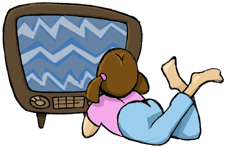Snapshots from a TV Album: Scenarios Explore Family Viewing Habits
|
This article originally appeared in Issue# 59-60
|
Two skits to help kids and parents reflect on TV viewing habits.
When TV was introduced in the late l940s, the upscale lifestyle magazine Better Homes & Gardens looked into the future and predicted that television would become a member of the family. Fifty years later, 98 percent of American households have welcomed television into their homes. Families spend more time with TV (an average of just over seven hours a day) than they do anything else but working and sleeping. Still, few people stop to examine when TV crosses the line from companion to intruder.
Its development has been gradual so we don't always notice it, but TV has established an almost human presence in our homes. We talk about television characters as if we knew them, and TV programs reflect our lives and our problems. Better Homes & Gardens was right. TV is a member of the family. It keeps us company when we're alone, entertains us when we have nothing to do, and helps us to relax after a hard day's work.
An unparalleled window on the world, television introduces us to faraway scenes, new concepts and ideas. Properly used, it is the most powerful educational device ever invented, with lessons to teach about human interactions, science and literature, history and current events. It can even provide us with instruction on human behavior and how to act. But much of what we learn is up to us. And there lies the major challenge of fulfilling television's potential.
Much of the downside of television, the side that makes us view it with ambivalence and distrust, is most visible in the family setting.
Use of multiple sets by different family members can increase individual isolation. Even families who view together have to struggle against the tendency to retreat into their separate media cocoons as TV's familiar wave washes over them.
With the skyrocketing number of single-parent and two wage-earning parent families, people rely more and more on TV to supervise their children. Despite its inherent educational potential, typical TV programming offers kids an easy way out when they're bored. Despite its learning potential, most typical programming fails to challenge children or engage their imaginations. It opens windows on new worlds, but also introduces them to an adult world they may not be prepared to deal with.
Even dinnertime, the traditional family catchup period, has been transformed by TV, with many families eating their way through the evening meal in silence as they watch the set.  In fact, American Demographics reports that 41 percent of adults don't talk with other family members during the course of an entire evening. Meanwhile, family conflicts go unresolved, as parents and children, grateful for the distraction of the TV set, leave matters unspoken.
In fact, American Demographics reports that 41 percent of adults don't talk with other family members during the course of an entire evening. Meanwhile, family conflicts go unresolved, as parents and children, grateful for the distraction of the TV set, leave matters unspoken.
But it doesn't have to be this way. With the right techniques and a little assertiveness, most viewers can learn to turn the tables on television by learning to recognize-and break-patterns of avoidance. You can begin this process by working through the scripts on the next page with friends and family members. Your interactive participations can be the first step in claiming and changing your relationship with TV.
All in the Family: What are your Viewing Habits?
Working with friends or family members, assign roles and act out the scripts below.

| Script 1: "Can We Talk?" Wife: What are we going to do about the bills, honey? Husband: I don't know what to do. I don't have the answers. (Goes to the TV as if to turn it on.) Wife: Please don't turn on the TV now. Husband: (Turning set on.) I really want to watch this show. (Watches over-intently, says nothing.) Wife: I want to get this settled and I can't talk to you if you're watching TV. Husband: Look, I'm tired. I worked all day. I want to relax. Wife: But when are we going to figure this out? Husband: Please. Can't you see I'm trying to watch?
|
| Script 2: "I Was Watching That." (A teenage boy sits in front of the TV set.) Dad: Haven't you watched enough TV for today? Son: Dad, I like this show. Dad: Maybe you should get some exercise. Son: (irritated) Dad, I'm trying to watch. Dad: Have you finished your homework? Son: (doesn't respond) Dad: (getting frustrated) You've been watching all afternoon. Why do you watch those shows? They're terrible. (The boy's sister enters and changes the channel.) Son: Hey, I was watching that. Daughter: That's a stupid show. Son: Dad, she just changed the channel! Dad: You shouldn't be watching that show anyway. Son: But I don't have anything else to do.
|
Discuss your reactions:
- What aspects of your own family's behavior do you recognize in the skits?
- How does your family viewing fit around other household activity?
- What do your family members get out of their TV viewing? When does TV viewing block communication between family members?
- How could each scene have been handled differently? Can you suggest how you might turn this into a positive interaction in the context of your family?



